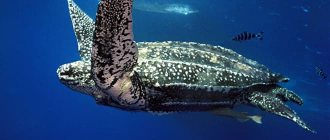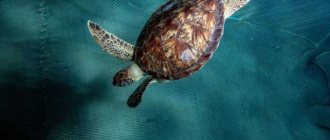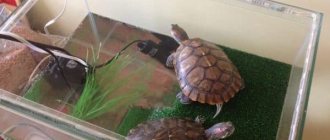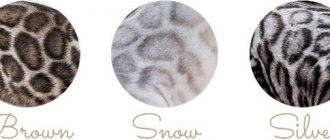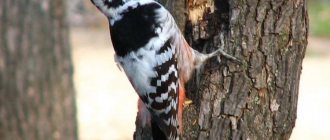A turtle is an amphibian animal that has a shell. This is an inextricable component of the body, which is firmly connected with it. In addition, it provides maximum protection for the reptile from various negative factors. But in nature there are individuals that lack a shell. In these animals, this area is covered with skin, which may contain small spines. In addition, a turtle without a shell looks very unusual and is very different from its relatives. Before you find out what kind of turtles these are and where they live, it’s still worth finding out in more detail why the presence of a shell is required and whether it is so important.
Turtles can be ruthless predators
Look
One of the fierce species is the snapping turtle. It can reach a length of up to 1.5 meters and weigh up to 60 kilograms. She has powerful jaws, a hooked beak, huge bear claws and a powerful tail. It lures its victims (sometimes it can even be other turtles) by moving its tongue, which is very reminiscent of a large seductive worm.
Lazy evolution
As you know, nature is very slow. Each, sometimes minor, change takes many years, or even hundreds of years. A striking example of this is Odontochelys semitestacea, or the ancient shellless turtle. More than two hundred million years ago, this amphibian really did not have its own “house” and was very easy prey for predators. Fortunately, evolution intervened and the turtle's great-grandmother received her first half of the shell - a shield on her belly.
Yes, yes, the turtle house was formed gradually, first its lower part, and then its upper. This is due to the fact that the main natural enemies of Odontochelys semitestacea most often attacked them from the belly. With the advent of a protective shield, a turtle without a shell became less vulnerable, but pretty soon predators learned to attack from the other side - from above. And then Mother Nature intervened again - Odontochelys semitestacea received its real, full-fledged shell, which we can still observe today.
Turtles don't have vocal cords (but they can still make sounds)
Look
Most turtles make hissing sounds. Some, however, can also make sounds that resemble grunting, hooting, or even cackling. They do this by jerking their heads in a way that compresses the air in their lungs.
What is a shell?
Most turtles are endowed with a dense protective shell, a bone “armor” consisting of dense scales, its structure is similar to human hair and nails. It is this that distinguishes them from other representatives of the class of reptiles and, perhaps, helped them not to become extinct, unlike dinosaurs. Most often this shell consists of two layers:
- plastron (abdominal part);
- carapace (dorsal part).
Both of them are covered with durable horny scutes, thanks to which the turtle can withstand a mass tens of times greater than its own weight. This covering consists of a large number of bones and looks like a rib cage located outside the body. Having its own circulatory system and vessels, it can bleed, causing pain.
However, some species have only a leather shell , which is not very dense; it was they who gave rise to the myth that the turtle is completely devoid of it. These include:
- leatherback sea turtle;
- numerous species of Trionics (three-clawed amphibians).
The weight of such reptiles is significantly lower, and their movement speed is higher. One can note a logical pattern provided by nature itself: if a turtle has a dense bone cover that provides maximum protection, then it is heavy and slow. If the shell is leathery, which does not protect so reliably from predators, then the animal’s speed is many times greater.
Cartoons often show how a turtle leaves its house for a while. But in reality this is impossible! The shell of this reptile is fused with the vertebrae and ribs , so it cannot be removed! But nevertheless, in the photo you can see what a turtle without protection looks like. It's a sad sight.
The outer cover is equipped with special holes through which the turtle exposes its head and limbs. Some species have moving parts that tightly close these openings in case of danger.
Owners of turtles should not forget that the shell is a part of the body, not a house! Therefore, the turtle needs a special place where the most comfortable conditions for it will be met.
Redness and swelling of the eyes
As a rule, such diseases occur due to poor turtle hygiene. Eye diseases are called ophthalmological. Symptoms are: the eyes may become swollen and cannot open, the eyelid is swollen and may stick together, the turtle cannot open the eyes, redness of the mucous membrane, a film on the eye, clouding of the cornea, loss of vision, fear of bright light, intense lacrimation, discharge from the eyes, decreased activity of the animal . The likelihood of ophthalmology occurs when the body is weakened after another illness.
When a disease is detected, it is important not to self-medicate, but to consult a doctor who will select the appropriate course. There are many eye diseases in water turtles, and they are easy to confuse - only a specialist will be able to determine exactly what needs to be done to ensure good health.
Types of Softshell Turtles
In nature, there are turtles that live without a shell. Of course, it is there, it’s just that in its place there is gray dense skin. Numerous small spines may appear on the surface of the skin.
These reptiles are large in size and belong to the group of freshwater turtles. There are three types of soft-bodied reptiles:
- Large;
- Cantori;
- Pelochelys cantorii.
Large softshell turtle
This species of reptile is distributed in the southern part of Papua New Guinea, as well as in the south of Irian Jaya in Indonesia.
Main features of the reptile:
- her carapace is round with a flattened structure;
- has large dimensions. The body length reaches 1 meter, and sometimes more;
- there are longitudinal stripes on the surface of the neck;
- in young animals, the carapace has medium roughness with small bumps. In adult reptiles, this part is smooth, it has skin with a slight roughness;
- the connection of the plastron and carapace is provided by ligaments with an elastic structure;
- reptiles of this species have a short but fairly wide head;
- at the end of the muzzle there is a small proboscis with nostrils.
Cantori
This soft-bodied turtle is large in size. Its distribution area is very wide. This reptile can be found in many Asian countries (India, Bangladesh, Thailand, Malaysia, South China and others).
Features of this type:
- This reptile is large in size. The length of the body can reach up to two meters, and the weight is almost 50 kilograms;
- the carapace has a smooth structure without spines or bumps;
- surface color olive-gray;
- This species lives mainly in freshwater bodies of water. It also adapts well in the depths of the sea with salty waters.
Pelochelys cantorii
The exact habitat of this species of soft-bodied reptile is not known exactly, but one thing can be said is that these reptiles are mainly found in the northern part of New Guinea.
What features does Pelochelys cantorii have:
- This amphibian animal lives in freshwater bodies of water. But sometimes it can enter the seas;
- prefers to be constantly in the water. During the day, it can float to the surface only 2-3 times;
- it comes to land in February-March, during which time it lays eggs.
In fact, every type of turtle has a shell, it’s just that it has changed greatly in different species of individuals under the influence of various factors. Even soft-bodied individuals have it, despite the fact that instead of it there is skin, this shell still fully performs its functions.
Bone (shell) diseases
The main symptoms in this case are softening or peeling of the shell. This can occur both due to a lack of ultraviolet radiation (artificial or natural), and due to a lack of calcium in the body. In baby turtles, shell abnormalities indicate the presence of rickets. Detachment of the scutes is also possible when infected with a fungal infection.
In order to prevent softening of the shell, it is necessary to irradiate the terrarium with a special ultraviolet lamp at strict intervals. By the way, similar devices for terrariums from the German company Hagen have proven themselves to be quite good. It is also necessary to eat chopped fish with bones (it is advisable to grind the bones) to supply the body with calcium.
Fungal disease of areas of the shell is easy to identify. Under the peeling shield, brown crusts and a gray coating are visible.
This case is treated by daily washing the affected area with a solution of methylene blue for 30 days.
In more complex cases (ulcers and even blood stains are visible under the shield), it is recommended to use clotrimazole medicinal ointment. The ointment is applied to the affected area in the evening, and the patient is left on dry land overnight. During the day, you need to carry out the washing procedure in a blue solution.
Interesting Facts
As we have already found out, a turtle without a shell existed only at the dawn of its evolution. What other interesting facts can you tell about them?
- The turtle's house consists of fifty different parts and only seems to us to be a single whole.
- The cervical spine of this amphibian consists of eight parts. To retract its head, the turtle is forced to fold its neck three times, in the shape of the English letter S.
Sources:
https://zoolog.guru/drugie-predstaviteli-fauny/mogut-li-cherepahi-pokidat-pancir-foto-cherepah-bez-pancirya.html https://nlo-mir.ru/palnetazemla/36111-12-neverojatnyh -faktov-kotorye-skryvajut-cherepahi-pod-svoim-pancirem.html https://fb.ru/article/245730/kak-vyiglyadit-cherepaha-bez-pantsirya-opisanie-osobennosti-i-interesnyie-faktyi
Intestinal diseases
The animal can become infected with parasitic worms (helminths).
They enter the body through contaminated foods (fish or meat), as well as after drinking contaminated water. If this happens, you can cure the turtle using a folk remedy: for 5 days, feed it only raw carrots, grated on a medium grater. A dangerous disease is salmonellosis, caused by intestinal bacteria. The animal develops loose stools with a very unpleasant odor, general apathy, and weight loss.
This disease can only be treated in a veterinary clinic, and the sooner the turtle’s owner goes there, the better. Otherwise, the death of your pet is inevitable.
Content Features
Caring for red-eared turtles is carried out at home using special equipment. Before purchasing, make sure you can create an optimal living environment. An Aquaterrarium with a volume of up to 100-200 liters is suitable.
The water must be changed no later than once a month; it must be warm (up to 28 degrees) and clean. Before pouring water, it must be left to stand for 5 days. Purchasing a filter will simplify the cleaning process.
The turtle needs to go to land in order to warm up and rest. Build an island with soil and equip it with an incandescent lamp to produce heat. In this case, there is no need to install an additional water heater.
This species of individuals is very mobile and therefore should not be underestimated. The height of the walls of the aquaterrarium must be at least 30 cm, otherwise the turtle may jump out of there, crawl into a hard-to-reach place and die from exhaustion.
Also, proximity to other animals or young animals may be unsafe. A predatory hungry turtle may start hunting.
Note!
- Indian snakes: sacred, poisonous, most common and dangerous types of Indian snakes and their names (130 photos)
Small snakes - an overview of popular and rare species, habitats, food and names of snakes (115 photos)
Snake bites - the most dangerous and poisonous snakes and the consequences of their bite (110 photos and videos)
Necrotizing stomatitis
Stomatitis is a lesion of the oral mucosa.
When the skin dies, stomatitis becomes necrotic. Externally, the disease manifests itself as follows: the turtle’s tongue becomes inflamed, mucus begins to flow from the mouth, later the gums become hyperemic, and the disease is difficult to bear. Doesn't eat anything. Stops eating food. It is rare that stomatitis comes alone; it usually causes many other diseases.
For treatment, the temperature should be increased by 6 degrees, bacterial preparations should be administered, and decamethoxin should be added inside. Purulent discharge must be removed from the mouth with a swab and tweezers.
What other health problems might owners of red-eared turtles face?
In fact, for all their vitality, reptiles are still prone to many diseases. The following changes in condition should alert the owner:
- The appearance of mucous discharge from the nasal or oral cavity . This symptom signals a viral disease or vitamin A deficiency. In these conditions, the cornea and the epithelial layer located in the reptile’s nose are affected.
- Swelling in the ear area . In red-eared turtles, these areas are marked with red stripes. Most often, swelling occurs due to otitis media. It can be practically invisible, not exceeding a few millimeters in volume, or significant, such tumors are measured in centimeters. Otitis often develops due to hypothermia, much less often due to injury to the turtle.
- Roll while swimming . This can happen for two reasons: the turtle swallowed stones or contracted pneumonia. In the first case, it is worth observing the behavior - if the reptile passes a lot of stones, then everything is in order, and it does not have intestinal blockage or other problems with the gastrointestinal tract due to what it has eaten. Most likely, the owner will have to remove small particles from the tank, leaving only those stones whose size does not allow the inhabitant to “profit” from them. Often such an eating disorder is associated with a lack of minerals in the body; it is worth consulting a veterinarian on this issue. When your pet has pneumonia, other signs of illness also appear: swelling of the eyelids and discharge from the sinuses.
- Swelling of the limbs . This is one of the main symptoms of gout, a joint disease caused by the accumulation of uric acid. The disease develops against the background of serious disturbances in the functioning of the kidneys, dehydration, or abnormally intensive growth of young animals. More often, the disease is detected by chance, less often - changes are detected on x-rays. Sometimes turtles show similar signs not because of gout, but because of arthritis, and then the reptile’s limbs fail. Other signs of gout include bloating of the body, swelling of the eyelids, enlargement of large joints and slight swelling of the area under the jaw. The disease is serious and requires treatment. Moreover, positive results can be achieved only in the initial stages of the pathology. And when changes become obvious, therapy is ineffective.
- Lethargy, apathy . If the behavior of the turtle has changed, it behaves less actively and more often prefers to lie down, it is worth taking a closer look at the condition of the reptile. First of all, you need to observe your pet; perhaps you will be able to identify other signs of the disease. With many diseases, lethargy and weakness are symptoms, so if the pet’s condition worries the owner, it is worth visiting a veterinary clinic with him. If you ignore such signs, you may lose your four-legged friend.
Many diseases are contagious, so a sick aquarium inhabitant should be immediately separated from the rest of the inhabitants. Newcomers should first be kept in quarantine. In many ways, the health of red-eared sliders is related to the conditions of their detention and the quality of food. And these factors depend on the owner - the more he pays attention to his pets and cares about their comfort, the longer they will delight with their presence.
AQUARIUM FOR THE RED-EARED TURTLE: CONTENTS, CARE, PHOTO, DESCRIPTION.
RED-EARED TURTLE: CONTENT, BREEDING, DESCRIPTION, FEEDING, PHOTO, VIDEO, CARE.
TURTLE: CARE, REPRODUCTION, FEEDING, DESCRIPTION, PHOTO, VIDEO
Lack of calcium and vitamin D3
A substance such as calcium is very important for turtles, because the formation of the shell, skeleton, and beak depends on its presence. With a severe deficiency of such a substance, this animal simply cannot live. She is lethargic and moves little.
Calcium deficiency is not always preceded by a low amount of calcium in the feed. There may be enough of it, but it will not be absorbed.
Vitamin D3 helps absorb this substance. It should also be present in the diet. However, it is important to know when to stop: an excess of vitamin D is worse than a deficiency.
Ultraviolet radiation also affects calcium absorption. It must be provided in accordance with the rules for keeping the animal.
Symptoms of calcium deficiency are: the shell loses its shine, flaws, cracks, and sometimes holes appear. At the first appearance of such problems, it is necessary to treat by adding calcium stone and more vitamin D to the food, as well as increasing ultraviolet radiation on the turtle.
Hearing diseases
A common disease that affects the auditory organs of turtles is otitis media. Its main danger is that the disease can be asymptomatic for a long time, and as a result lead to serious health problems or death of the animal. You can suspect the presence of otitis media by the following signs:
- the animal has a swollen cheek and asymmetry of the head is observed;
- the turtle does not show interest in food and the surrounding reality;
- the coordination of the individual’s movements is impaired.
Otitis in turtles can be unilateral or bilateral, when the swelling is visible only on one side of the head or both cheeks have increased in size. With such a disease, three scenarios are possible:
- breakthrough of pus through the skin;
- exit of masses through the oral cavity;
- the need for surgical intervention.
In the first case, you will need to treat the wound formed after the breakthrough of pus with antimicrobial agents and healing ointments.
In the second case, when the pus does not break out on its own, you need to massage the problem area, lightly pressing on the swelling. After the purulent discharge begins to come out, it will be necessary to remove these masses from the animal’s mouth. When massages do not bring the expected result, surgery is performed, the purulent focus is opened, and the canals are washed. During the rehabilitation process after otitis, the animal will need vitamins and injections of calcium gluconate.

